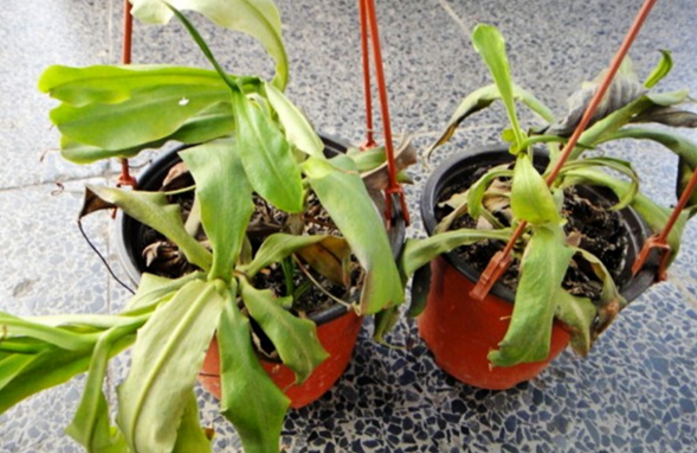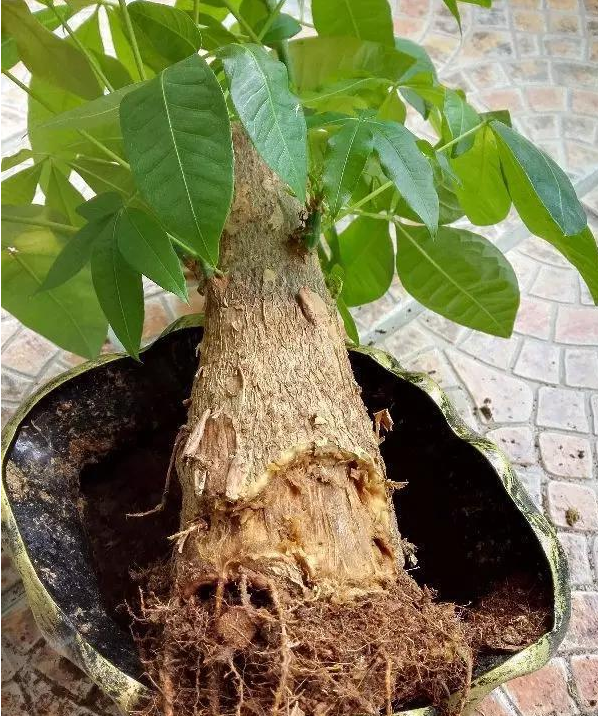How do you make the leaves brown? Why do you roll them?
Speaking of this pitcher plant, this pitcher plant has a characteristic that many plants have wood, this pitcher plant is to eat meat, to see how the pitcher plant leaves yellow? Why are the pitchers rolling:

What to do when the piglet leaves are yellow:
1. Yellow water
Too much watering causes yellowing of leaves, mainly manifested as yellow and dull leaves newly grown, but no obvious changes in old leaves.
Solution:
Immediately stop watering, control water, and directly turn over the pots for new soil when it is serious.
2, drought yellow
Drought-yellow means water shortage, showing that the old leaves gradually turn yellow from bottom to top, and the new leaves grow slowly. If the water shortage lasts for a long time, the whole plant will turn yellow or even die.
Solution:
Timely watering. If not watered for a long time, do not water too much for the first time, but gradually. Or water them by immersion irrigation.
3, fat yellow
Fertility yellow is also produced fertilizer harm, due to excessive fertilization or excessive concentration caused. The main performance is that the newly grown leaves are relatively plump and shiny, but the leaves are uneven.
Solution:
Water in time to dilute the fertility of the soil. Or turn the soil, control the fertilizer.
4, hungry yellow
Nepenthes does not need too many nutrients to grow, but it does not mean that it will grow well without fertilization, and its leaves will turn yellow without fertilization for a long time. Long-term not fertilized performance for the new stem, leaf yellow, if not timely fertilizer, will cause plant death.
Solution:
Avoid applying a large amount of fertilizer at one time, and adhere to the principle of supplementing fertilizer in small quantities for many times.
5, iron deficiency yellow leaves
Just like humans, Nepenthes need iron to grow, and yellow leaves appear when iron is deficient. The leaves will appear distinctly yellow.
Solution:
Spray ferrous sulfate solution, 3~4 times will gradually improve.# p#subtitle #e#
Why are the leaves of pitchers curled:
1. Not enough humidity
Nepenthes needs 80% humidity to grow, and the humidity in the living room of the home is not up to standard. Even if it is watered frequently, the air humidity still does not meet the growth requirements of Nepenthes, so that the leaves roll.
2. Excessive fertilization
Nepenthes need fertilizer to grow, but not necessarily man-made fertilizer. Nepenthes traps prey on insects, and they get nutrients directly from the decomposition of insects to meet some of their nutrient needs. If too much fertilizer is applied, even once, Nepenthes will react directly and its leaves will wither.
3. Too much watering
Many flower friends do not know how to water when they care. The bottom of the pot will cause imperceptible accumulation of water, and in the long-term environment of excessive flooding, the pitcher plant itself is stimulated to respond, wilting and rolling.
Leaf rolling processing method:
1. Increase humidity
Spray water regularly around the leaves to increase air humidity. If conditions permit, Nepenthes can be placed on the windowsill of a bathroom with sunlight, without frequent spraying and ensuring good humidity. But to ensure that the bathroom has better sunlight, and there is no smell.
2. Reasonable fertilizer control
Don't fertilize all the time. In fact, adhere to the principle of small amount of fertilizer for many times in growth. Sprinkle a thin layer of fertilizer on the soil surface once every half month. When the leaves are rolled, reduce the fertilizer amount appropriately.
3, correct watering
Too much watering is actually the wrong way to water. When watered incorrectly, plants can easily wither and their leaves curl.
This is where the yellowing of Nepenthes leaves is introduced. If the leaves of Nepenthes are curled, there are other ways to deal with them.
What should I do with the yellow leaves of the pitcher plant?
water yellow
Too much watering causes yellowing of leaves, mainly manifested as yellow and dull leaves newly grown, but no obvious changes in old leaves.
solutions
Immediately stop watering, control water, and directly turn over the pots for new soil when it is serious.
drought yellow
Drought-yellow means water shortage, showing that the old leaves gradually turn yellow from bottom to top, and the new leaves grow slowly. If the water shortage lasts for a long time, the whole plant will turn yellow or even die.
solutions
Timely watering. If not watered for a long time, do not water too much for the first time, but gradually. Or water them by immersion irrigation.
fat yellow
Fertility yellow is also produced fertilizer harm, due to excessive fertilization or excessive concentration caused. The main performance is that the newly grown leaves are relatively plump and shiny, but the leaves are uneven.
solutions
Water in time to dilute the fertility of the soil. Or turn the soil, control the fertilizer.
hungry yellow
Nepenthes does not need too much nutrients to grow, but it does not mean that it will grow well without fertilization. The leaves will also turn yellow without fertilization for a long time. Long-term not fertilized performance for the new stem, leaf yellow, if not timely fertilizer, will cause plant death.
solutions
Avoid applying a large amount of fertilizer at one time, and adhere to the principle of supplementing fertilizer in small quantities for many times.
iron-deficient yellow leaf
Just like humans, Nepenthes need iron to grow, and yellow leaves appear when iron is deficient. The leaves will appear distinctly yellow.
solutions
Spraying ferrous sulfate aqueous solution, 3~4 times will gradually improve.
What about the yellow leaves of the pitchers?
Nepenthes leaves are complex in structure, divided into petioles, leaf bodies and tendrils. The tendril tail expands and rolls back to form a bottle shape, which can prey on insects. Nepenthes plants have racemes with green or purple flowers, and the bottle-like body at the top of the leaf is a tool for catching insects. What about the yellow leaves of Nepenthes? What about yellow pigtails? The following wed114 wedding network Xiaobian brings you detailed content.
What about the yellow leaves?
1. Yellow water
Too much watering causes yellowing of leaves, mainly manifested as yellow and dull leaves newly grown, but no obvious changes in old leaves.
Solution:
Immediately stop watering, control water, and directly turn over the pots for new soil when it is serious.
2, drought yellow
Drought-yellow means water shortage, showing that the old leaves gradually turn yellow from bottom to top, and the new leaves grow slowly. If the water shortage lasts for a long time, the whole plant will turn yellow or even die.
Solution:
Timely watering. If not watered for a long time, do not water too much for the first time, but gradually. Or water them by immersion irrigation.
3, fat yellow
Fertility yellow is also produced fertilizer harm, due to excessive fertilization or excessive concentration caused. The main performance is that the newly grown leaves are relatively plump and shiny, but the leaves are uneven.
Solution:
Water in time to dilute the fertility of the soil. Or turn the soil, control the fertilizer.
What about the yellow leaves?
4, hungry yellow
Nepenthes does not need too many nutrients to grow, but it does not mean that it will grow well without fertilization, and its leaves will turn yellow without fertilization for a long time. Long-term not fertilized performance for the new stem, leaf yellow, if not timely fertilizer, will cause plant death.
Solution:
Avoid applying a large amount of fertilizer at one time, and adhere to the principle of supplementing fertilizer in small quantities for many times.
5, iron deficiency yellow leaves
Just like humans, Nepenthes need iron to grow, and yellow leaves appear when iron is deficient. The leaves will appear distinctly yellow.
Solution:
Spraying ferrous sulfate aqueous solution, 3~4 times will gradually improve.
- Prev

The cure for the rotten roots of a rich tree. Can the leftover soil be used when it dies?
Rich tree, this is a lot of people like breeding, the growth is so good-looking, but also very lucky, let's take a look at the treatment of the rotten roots of the rich tree.
- Next

How to manage Scutellaria baicalensis in the field
How to manage Scutellaria baicalensis in the field
Related
- Fuxing push coffee new agricultural production and marketing class: lack of small-scale processing plants
- Jujube rice field leisure farm deep ploughing Yilan for five years to create a space for organic food and play
- Nongyu Farm-A trial of organic papaya for brave women with advanced technology
- Four points for attention in the prevention and control of diseases and insect pests of edible fungi
- How to add nutrient solution to Edible Fungi
- Is there any good way to control edible fungus mites?
- Open Inoculation Technology of Edible Fungi
- Is there any clever way to use fertilizer for edible fungus in winter?
- What agents are used to kill the pathogens of edible fungi in the mushroom shed?
- Rapid drying of Edible Fungi

